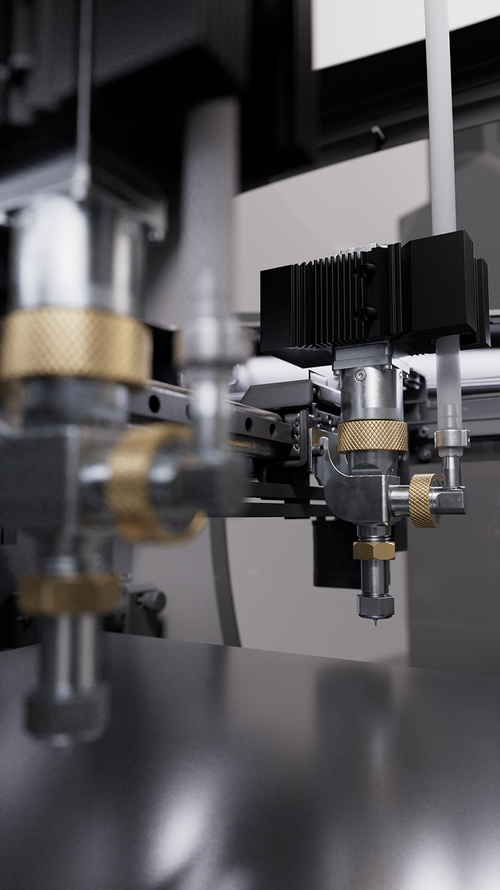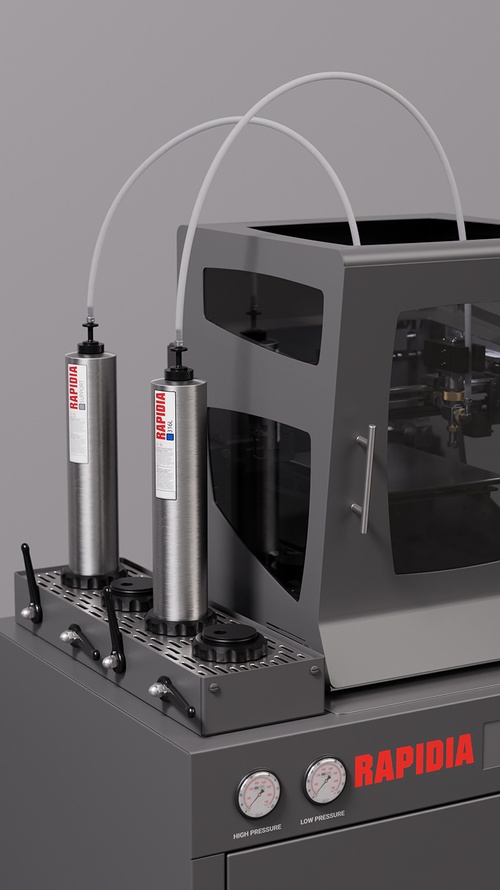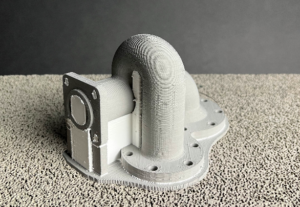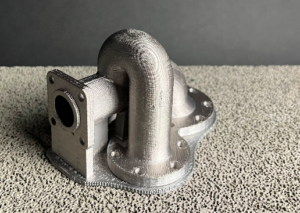In the lead up to their merger, there was an interesting bout of competition between Desktop Metal (NYSE: DM) and ExOne. In the process, the latter company made a unique agreement with Canadian metal 3D printer manufacturer Rapidia to sell its products under the ExOne brand, with the possibility of acquiring the startup in the future. However, when Desktop Metal acquired the metal binder jetting pioneer, Rapidia seemingly dropped out of sight.
In the past year, the firm has re-emerged, returning to the market with a newly priced and branded bound metal 3D printer, the Conflux 1. Ready to take on the 3D printing industry once more, Rapidia has re-introduced its Metal Paste Deposition technology with a starting cost of less than $100,000. At the 2023 Additive Manufacturing Users (AMUG) Conference, we were able to catch up with CEO Artem Bylinskii to learn more.
Metal Paste Deposition vs Bound Metal Extrusion
As the battle between Desktop Metal and ExOne heated up, a key product Desktop had over its competitor was an entry level machine for bound metal extrusion, the Studio System. To catch up, ExOne’s deal would allow its customers to leverage Rapidia’s metal paste deposition as an entry point into the world of sintered metal printing. Not only that, but Rapidia’s technology offered a number of benefits over the Studio System, as well as the similarly competitive Metal X machine from Markforged.
“It is inherently different than the other bound metal systems where the powder is bound by a polymer,” Bylinskii said. “[With metal paste deposition], the carrier is water. The water evaporates during printing and what comes off the printer is effectively the brown part.”

Independent dual extruders allow Conflux 1 to print two materials in the same print. Evaporative support material enables printing of nearly any shape and overhang.
The distinction between a “green” and “brown” component is an important one. A green part still requires a de-binding step, in which the polymer binder that holds the metal powder together must be dissolved out. This results in a brown component that must then be baked in a furnace for final sintering.
Because metal paste deposition relies on water as a binder, which evaporates during printing, there is no de-binding step, increasing the speed of the overall workflow significantly. This is in addition to the speed gained from the fact that the printing material doesn’t need to be melted out of an extruder, as with polymer-based metal extrusion. The brown components can undergo some post-print treatment, including sanding, light machining, and water smoothing, the last of which is unique to Rapidia’s process.

Feedstock cartridges can be stored at any fill level, with stainless steel feedstock containers reused via Rapidia’s cartridge exchange program.
Rapidia’s Vacuum Sintering Furnace
Rapidia has also developed its own sintering furnace, capable of running a rapid cycle of just 12 hours, another novel element of the company’s workflow. Naturally, the furnace and printer are complementary, but each can be purchased individually. Altogether, a part can be completed in under 24 hours, typically a drastic difference compared to other workflows that require a de-binding step and slower furnace cycle.
- The brown part
- Post sintering
“The problem with the majority of other sinter-based technologies is that furnaces cannot be moved after the first time they’ve been to temperature. All of these furnaces you bring on can’t move an inch or you void your service contract,” Bylinskii said. “There are components in there that will just disintegrate. With our furnace, there’s some specialty material they’ll allow you for the furnace to be moved.”
For this reason, military customers are interested in the technology because it means that both the printer and the furnace can be ruggedized and then shipped to the point-of-use, whether that is a repair facility or the field of war.

U.S. military supplier Integrated Solutions For Systems and Rapidia designed a ruggedized shipping container system for the Conflux 1 and its furnace for deployable metal 3D printing. Image courtesy of Rapidia.
Sub-$100,000 Metal 3D Printing Package
In the year that Rapidia spent after the Desktop Metal-ExOne acquisition, the company built out a sales team and network. Now, it has returned to the market with a lower-priced package, in part thanks to the ability to control the entire customer journey. A single Conflux 1 3D printer and vacuum sintering furnace can be purchased starting from $99,000 USD.
“We want the machine to be accessible to anyone anywhere, so we have to make it financially accessible. Our competitors are priced around the $200,000 range all in. They’ll quote their hardware much lower, but when is said and done, it comes out to be around $200- or $220,000, and we find that that’s just too high of a barrier for most people.”

The Conflux 1 with sintering furnace.
As an entry-level machine, the Conflux 1 is designed for prototyping, research and development, and production cases with high part mix and very low volume. For these reasons, the return on investment (ROI) may be harder to quantify for an organization’s decision maker, who might reject such equipment, regardless of manufacturer, at a higher price. However, a package that comes in at under $100,000 has a psychological threshold that really makes it easier to facilitate a purchase. Skyler Des Roches, Head of Customer Experience, pointed out that the company’s work on cemented carbide and other unmachinable materials are the sorts of production cases that could prove convincing for building out a small print farm with three or four printers per furnace.
Since the deal with ExOne fell through upon its acquisition by Desktop Metal, Rapidia has been in the process of ensuring that the market knows that it is still here and a completely separate entity from Desktop Metal. As this information permeates trade shows and the press, the distinction between Rapidia and its former business partner will become clearer.
At the same time, the Canadian startup will further distinguish itself through its product offerings. Bylinskii said that the company is trying to both print and sinter even faster, potentially going from a 12-hour sinter cycle to just six. Meanwhile, it’s possible that Rapidia will find itself another, more fruitful partnership with a metal binder jetting company that will be able to introduce the Conflux 1 as an entry-level introduction to sintered metal that can lead to full-scale metal binder jetting. With the bound metal segment representing the fastest growing in AM, it’s no surprise then that the “Bound Metal & Metal Binder Jetting AM 2022” from SmarTech Analysis anticipates that metal binder jetting and bound metal extrusion technologies will produce $54 billion in parts through 2030.
Subscribe to Our Email Newsletter
Stay up-to-date on all the latest news from the 3D printing industry and receive information and offers from third party vendors.
Print Services
Upload your 3D Models and get them printed quickly and efficiently.
You May Also Like
Havaianas Collaborates with Zellerfeld to Launch 3D Printed Flip-Flops
The shoe of the summer is undoubtedly the flip-flop. Easy on, easy off, your feet won’t get sweaty because there’s not much material, and they’re available in a veritable rainbow...
UCLA Researchers Develop 3D Printed Pen that May Help Detect Parkinson’s Disease
Diagnosing Parkinson’s disease is difficult. Often, early symptoms of the progressive neurological condition may be overlooked, or mistaken for signs of aging. Early diagnosis can help save lives and improve...
Printing Money Episode 30: Q1 2025 Public 3D Printing Earnings Review with Troy Jensen, Cantor Fitzgerald
Printing Money is back with Episode 30, and it’s that quarterly time, so we are happy and thankful to welcome back Troy Jensen (Managing Director, Cantor Fitzgerald) to review the...
Heating Up: 3D Systems’ Scott Green Discusses 3D Printing’s Potential in the Data Center Industry
The relentless rise of NVIDIA, the steadily increasing pledges of major private and public investments in national infrastructure projects around the world, and the general cultural obsession with AI have...


































